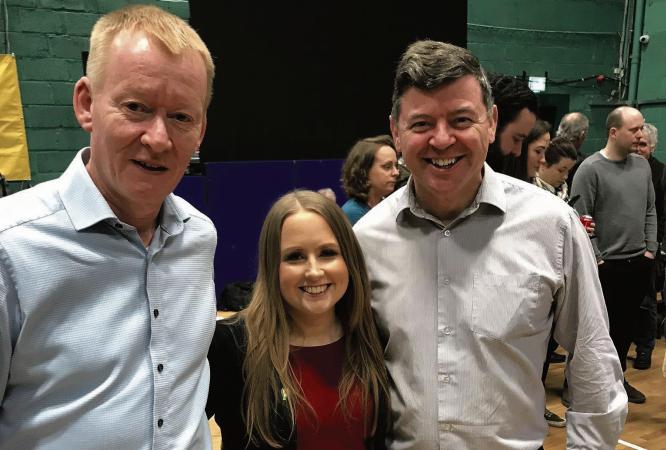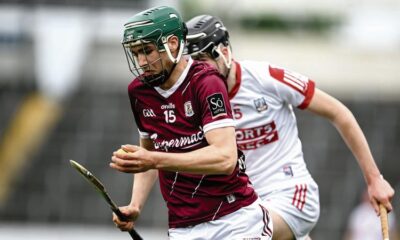Political World
Sinn Fein on track for big gains – but not for government

It’s a quieter time of year and I suppose you get a little bit more room for reflection.
Since May, everybody has been talking about the rise in Sinn Féin and I suppose their success in both the European and local elections signalled the fact it has arrived as a major force in southern politics.
The party is still in third place and will probably remain in that position after the next General Election.
In the long term, however, many are convinced that Sinn Féin will eclipse one of the two major parties (and Fianna Fáil looks the more likely at this stage), forcing them into a coalition.
Leo Varadkar, the big star of the Coalition at the moment, said after the May elections that the next General Election in 2016 would be a battle between Fine Gael and Sinn Féin.
It’s not that they will battle it out to the death. It’s just that the big ideological debates in the election campaign will boil down to clashes on the views espoused by Fine Gael and Sinn Féin.
Fianna Fáil and Labour will be generally seen as being close to the Fine Gael camp, except for a number of small but significant issues (Fianna Fáil in particular is closer to Sinn Féin on the national question – marginally closer only – and is very close to Sinn Féin when it comes to Irish language policies).
How well will the party do? If things don’t change dramatically over the next 18 months, fabulously. It’s going to be in contention for multiple seats in constituencies where the party is strong.
You can take it that Sinn Féin will take two seats in Donegal, Louth, Cavan-Monaghan and maybe a constituency like Dublin South-West. They have an outside chance of taking three out of five in one or two constituencies.
And they could take seats in a rake of constituencies where they had a pimple of a presence as recently as 2011 – Galway West is now a definite target.
The party has established an identity as the main out-and-out Opposition party, with a consistent anti-austerity message.
You see a lot of the moves and you wonder for if Sinn Féin really believes its own rhetoric (hmmm, a tough one, I’ll come back to you on that in future) or is just being cynical. Of course, there’s cynicism and opportunism there but it’s no different to any of the other parties.
Bertie Ahern was right in 2005 when he said it would take 20 years for it to complete the same journey as the Workers Party did. The party still has the discipline instilled from the military past. Its representatives are always on message.
It went to the point of farce when it actually came up with a whipped party viewpoint on the Garth Brooks concert. It has a lot of bright people but some are pretty hardline. It has more people working for the party (61) centrally than any of the other parties and the majority of its 150-plus councillors will be full-timers giving fealty to the party over any job or career.
Just as Varadkar has magically assumed an image as a straight talker, Sinn Féin has garnered an image of a possible alternative government.
Its opponents said that being in power in local authorities would remove a lot of its bite. But local government is second-tier and if things go wrong you can always blame central government.
I’d be surprised if Sinn Féin get really punished or tested in 2016.
Despite the change of leadership, Labour, like all minority coalition parties, will struggle to contain its losses. Fine Gael will lose seats too. Fianna Fáil will gain but not as solidly as seemed maybe a year ago (the party is a little becalmed at present, as the great Éamon Ó Cuív might put it).
Sure, some of the splinter parties will make modest gains, and the Reform Alliance may gouge at the edges of Fine Gael.
But the big winners will be Sinn Féin. People vote with their pockets in general elections.
Sure, Sinn Féin will find its pretty unconvincing economic policies subject to very rigorous scrutiny. If the answer to the Hillary Clinton question of ‘who do you call at 3am when the economy is on the verge of collapse’ is Sinn Féin, you might start to worry a little.
Connacht Tribune
The fine art of good timing when it comes to elections

World of Politics with Harry McGee
Academically, politics is described as a science. But in the real world, it’s more of an art – and one of the big decisions a Government has to make is to decide when to call an election.
Will they see out the full term, or will they go early – either to mitigate the damage they will ship, or to secure a victory before things go awry, or the economy takes a dip, or some kind of controversy erupts?
Timing is everything.
And there’s a bit of art to that – not to mention a lot of luck. If you call it early and win big, you’re a genius. If you call it early and lose, you are the political version of the village fool.
Charlie Haughey was a poor judge of the public mood. Twice he called snap elections and on both occasions they backfired. Haughey succeeded Jack Lynch as Taoiseach in late 1979 and did not – technically – have his own mandate. He tried to remedy that by calling an election in 1981. But it recoiled. Ray MacSharry warned him not to hold it during the H Block hunger strikes when republican prisoners were dying each day. He did not listen to the advice and found himself out of office.
After his return to power in 1987, Haughey tired of presiding over a minority government that kept on losing votes in the Oireachtas (the opposition won nine private members motions).
So he called a snap general election and it backfired. Fianna Fáil lost seats and had to broker a coalition deal with the Progressive Democrats and his long-standing political adversary Dessie O’Malley.
For more, read this week’s Connacht Tribune.
Connacht Tribune Digital Edition App
Download the Connacht Tribune Digital Edition App to access to Galway’s best-selling newspaper.
Click HERE to download it for iPhone and iPad from Apple’s App Store, or HERE to get the Android Version from Google Play.
Or purchase the Digital Edition for PC, Mac or Laptop from Pagesuite HERE.
Get the Connacht Tribune Live app
The Connacht Tribune Live app is the home of everything that is happening in Galway City and county. It’s completely FREE and features all the latest news, sport and information on what’s on in your area. Click HERE to download it for iPhone and iPad from Apple’s App Store, or HERE to get the Android Version from Google Play.
Connacht Tribune
Inch protest arguments are more subtle than Oughterard

World of Politics with Harry McGee
I was cycling down Mount Street in Dublin on Tuesday. It’s a wide esplanade that links the Grand Canal with Merrion Square. The street is a mixture of fine Georgian buildings and modern office blocks.
About half-way down is the office of the International Protection Office, which deals with asylum seekers who have arrived in the country.
Needless to say, the office has been overwhelmed in the past year. Besides an estimated 80,000 refugees who have arrived from Ukraine, there have been about 20,000 people from other parts of the world who have arrived into Dublin (mostly) claiming asylum.
The numbers peaked around Christmas, but they have been falling a little. In January, more than 1,300 people arrived seeking asylum but the numbers fell back to 831 and 858, in February and March respectively.
They are still huge numbers in a historical context.
So back to my cycle on Tuesday. I knew that some asylum seekers were camping outside the International Protection Office, but I was taken aback by how many. There were six tents lined up on the pavement directly outside. Then on the ramp that led down to the basement carpark on the side of the building, there were about another 20 tents.
It looked like what it was, a refugee camp in the middle of Dublin’s business district. If you pan out from Mount Street, you will find tents here and there in nearby streets and alleys. There were a good few tents in an alleyway off Sandwith Street about 500 metres away.
For more, read this week’s Connacht Tribune.
Connacht Tribune Digital Edition App
Download the Connacht Tribune Digital Edition App to access to Galway’s best-selling newspaper.
Click HERE to download it for iPhone and iPad from Apple’s App Store, or HERE to get the Android Version from Google Play.
Or purchase the Digital Edition for PC, Mac or Laptop from Pagesuite HERE.
Get the Connacht Tribune Live app
The Connacht Tribune Live app is the home of everything that is happening in Galway City and county. It’s completely FREE and features all the latest news, sport and information on what’s on in your area. Click HERE to download it for iPhone and iPad from Apple’s App Store, or HERE to get the Android Version from Google Play.
Connacht Tribune
Sinn Féin hunt for seats in ‘locals’ across Galway

World of Politics with Harry McGee
God that was a dramatic and historic weekend in England, wasn’t it? So much excitement, so much change, so much hype, so much out with the old and in with the new, and what looks like the coronation of a new leader. Yes, the local elections in Britain were something else weren’t they!
Apologies for not going on about King Charles III but the contract I signed when I became a lifelong republican forbids me to discuss the topic!
I know the British local elections sound a bit boring by comparison, but the results were stunning.
The Conservatives lost nearly 1,000 seats, the British Labour Party gained almost 500 and both the Lib Dems (with 350 gains) and the Greens (gaining over 200) also had amazing days at the polls.
It was Labour’s best day since 2002 but its victory was only partial. The Greens and the Lib Dems actually made gains at the expense of Labour in more affluent areas, and in parts of Britain where there were high numbers of graduates.
It was in the Red Wall constituencies in the North of England where the Labour recovery was strongest. These are working class constituencies with pockets of deprivation where people voted for the Labour Party forever. But all of those constituencies voted for Brexit and then voted for the Tories in the next general election. Labour is now winning back some of those votes.
Local elections are classified as second-tier elections which essentially means – from a national perspective – they are not life-or-death affairs, and not everything turns on them. Of course, it’s really important to have good local representation. But they are not an amazing weather vane for who rules the country.
For more, read this week’s Connacht Tribune.
Connacht Tribune Digital Edition App
Download the Connacht Tribune Digital Edition App to access to Galway’s best-selling newspaper.
Click HERE to download it for iPhone and iPad from Apple’s App Store, or HERE to get the Android Version from Google Play.
Or purchase the Digital Edition for PC, Mac or Laptop from Pagesuite HERE.
Get the Connacht Tribune Live app
The Connacht Tribune Live app is the home of everything that is happening in Galway City and county. It’s completely FREE and features all the latest news, sport and information on what’s on in your area. Click HERE to download it for iPhone and iPad from Apple’s App Store, or HERE to get the Android Version from Google Play.












